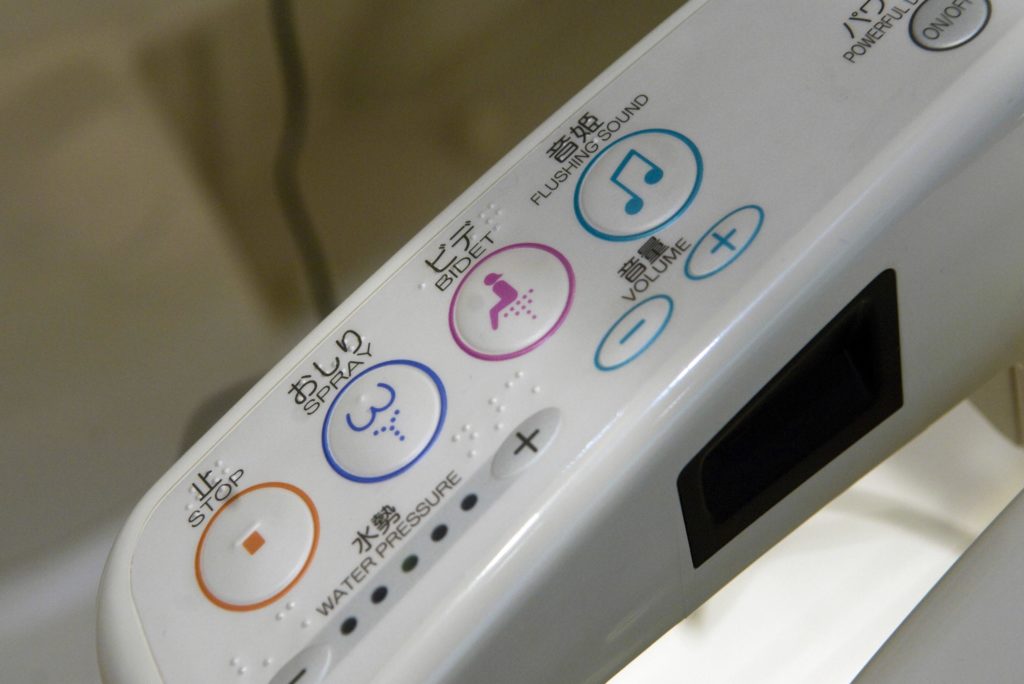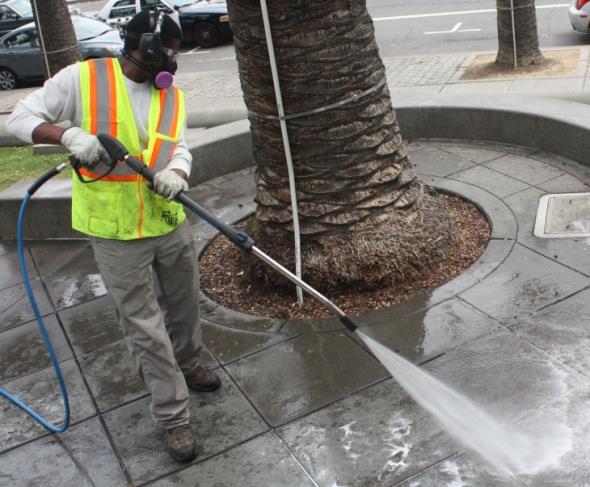In honor of the vacation we are currently enjoying, I’m finally pulling out a topic I’ve wanted to cover for a long time. This post is about an amazing invention that is pretty standard across Japan and almost absent in America: the bidet. These devices are touted as more resource-friendly and bum-friendly than toilet paper, but the topic still seems to be avoided in polite conversation. And that’s what I’m here for – to do research and mention unmentionables.
Traditional bidets are separate fixtures from the toilet used to clean oneself with a stream of water after going to the bathroom – I am not familiar with those and have never encountered one. This post will be about the more space-economizing bidet attachment that takes the place of a standard toilet seat and is typically easy enough to install yourself. I must admit the first time I ever used one, it was a weird experience, but now I miss it when I don’t have the option. We purchased one after we returned home from Christian’s first trip to Japan.
The benefits of bidets are many, especially if you can afford a nicer model. In addition to cutting down on toilet paper needs, they can provide relief for a number of health issues, such as hemorrhoids, irritable bowel syndrome, ulcerative colitis, and other conditions.[1] As far as added features, you can get things like a seat warmer (the biggest thing I missed about my apartment in Japan), temperature and pressure control, and a drying function. Curious friends have tried ours while visiting, and their responses have ranged from “it was weird – not in a bad way” to “I think I need a cigarette.”

Photo by Andy Nelson/The Christian Science Monitor/Getty Images
Image credit: [2]
Common Concerns
I know several people who are hesitant to try it because it freaks them out a little bit, but I had never heard any more serious objections until I started digging into some preliminary research. One voice of opposition I found was in a public health school newsletter. There are no citations to the studies or anecdotes the author mentions (which I find concerning for a health publication), but according to this article, “the main risks of bidet use include disruption of natural flora and increased risk of infection, perianal region damage, and physical injuries from falls or burns.” The author also mentions potential anal damage from high pressure jets and bacterial vaginitis caused by disruption of micro flora in the vagina.[3]
Regarding injury:
I won’t say that these are impossible, but I will say that when I read that
quote to Christian, we both got the mental image of a high-PSI water jet used
for cutting stone in industrial applications.
Is it possible that someone may have been injured at some point? Sure. I
couldn’t find specific instances of bidet-related injuries, but if it happened
to me, I know I wouldn’t want it to be on the news. The only actual news story I could find regarding
the danger of bidets was about one model made by Toto in 2007 that tended to
catch fire.
Regarding health:
It does appear that overuse for extended times and/or at high pressures can
cause disruption to beneficial bacteria and mucous membranes. For example, a 2010 study of 268 women concluded
that “habitual use of bidet toilets aggravates vaginal microflora, either by depriving
normal microflora or facilitating opportunistic infection of fecal bacteria and
other microorganisms.”[4]
I would say the key there is
remembering that the purpose of the device is to rinse, not pressure wash.[5]
Regarding cleanliness:
At least one source claims that cleanliness of the water is a concern and
that it can introduce bacteria. The
study above noted that “contamination by other pathogens was four to six times
higher in users than in non-users.”
The model we have is self-cleaning, as is the most popular model in
Japan, but I don’t have any information about the models or features used by
women in the study. Meanwhile, other
sources assert that bidets are more hygienic than toilet paper.[6]
As for me and my personal experience, I had one in Japan for two years and loved it. We have had one at home for over a year now, and I love it. I have had no problems with yeast infections or anything of that nature. I have had no problems using it, and I feel like it cleans better than toilet paper. The water stream is not what I would consider high pressure or hot, even at the highest settings for both – yes, both of those preferences are adjustable on the model we have. Additionally, Christian is happy about our (my) decreased use of toilet paper, which brings me to my next point.

Image credit: [7]
Avoided Waste
The US is the largest consumer of toilet paper in the world.[8] One source claims that “on average, every American uses three rolls of toilet paper each week (28 pounds per year), meaning that just 4 percent of the world’s population is responsible for 20 percent of total tissue consumption.”[9] I’m not sure I’ve ever used three rolls a week in my life, except maybe whenever I’ve had a bad cold and was also using toilet paper to blow my nose. I have not tracked our toilet paper usage (and it’s hard for me to guess since I’m not even the one who does the shopping), but I do know that it has dropped significantly over the last year since we got the bidet.
Regarding paper:
Scientific American says that switching to bidets could help Americans save
some 15 million trees that go to make 36.5 billion rolls of toilet paper used
annually in our country. Additionally,
our annual demand for toilet paper production requires 474 billion gallons of
water, 253 thousand tons of chlorine for bleaching (because it would be gross
to use anything other than white toilet paper), and 17.3 terawatts [sic – it should
be terawatt-hours… I’m disappointed in Scientific American] of electricity, not
to mention the oil needed for transportation and plastic packaging.[10]
Part of the reason why toilet paper manufacturing has such a sizable impact is that many leading brands of toilet paper make their product from virgin wood,[11] much of it from old-growth Canadian forests. NRDC and Stand.earth developed a scorecard of sustainable toilet paper, and the higher-rated brands use higher percentages of recycled content.[12]
Regarding electricity:
A note on that electricity number: 17.3 terawatt-hours electricity is in
the trillions of watt-hours; total annual use for the average US household is
on the scale of millions of watt-hours.[13] I want to do additional research in the
future around the footprint of manufacturing a bidet and using it because it
does require electricity to operate. Websites
I have seen thus far still say that the impact of the toilet paper industry
still outweighs that of the bidet industry, but I want to check those numbers
for myself, particularly the ongoing electricity use.
Regarding water:
One final concern I have heard is the extra use of water related to bidets
use. According to bidet.org, a bidet
uses an average of 1/8 of a gallon per use.[14] Compare that to 37 gallons of water required
to make a roll of toilet paper (no detail on what size roll “average” is) – at
an estimated 200 sheets per roll and a very scant 6 sheets per bathroom trip
(apparently average is 8-9),[15]
that comes out to anywhere between 3/8 of a gallon (based on Metaefficient’s
numbers) to over a gallon (based on Treehugger’s numbers) for the toilet paper.

Image credit: [16]
Personal Experience
At the very least, we can say that bidet use is better than toilet paper from both the paper and water perspectives. I’m not going to take a position on the plastic or electricity impact until I can crunch the numbers myself. At the moment, my biggest (only?) objection to our bidet is how long it takes to dry off after using it. Sometimes I’m in a hurry and don’t have the luxury of sitting in a warm stream of air for several minutes. In that case I still use a small amount of toilet paper to speed up the process. With that current behavior, we have cut down drastically on toilet paper usage, but we haven’t eliminated it.
As far as making that process even more sustainable, I have a friend who uses reusable toilet cloths: a stack of clean, absorbent fabric squares that can be used to pat yourself dry afterwards and then be dropped into a bin bound for the laundry.[17] The concept is actually cleaner than washing and reusing cloth diapers for babies, but I must admit it gave me pause the first time I heard about it. I am not necessarily opposed to this idea, though I have not yet seriously considered implementing it. I know I would be comfortable using them myself, probably be OK if my husband used them too, but I definitely wouldn’t leave them out for company.
Do you have opinions or perceptions about bidets, either way? Feel free to share your thoughts below.
Thanks for reading!
[1] https://www.bidet.org/pages/bidets-for-health-issues
[2] https://www.cnn.com/2017/11/17/asia/gallery/toto-toilet-controls/index.html
[3] https://thephinnewsletter.wordpress.com/issues/october-2011-3/public-health-perspective/
[4] https://www.ncbi.nlm.nih.gov/pubmed/21058441
[5] https://soranews24.com/2012/11/23/a-frank-discussion-about-anuses-and-why-washlet-toilets-may-be-bad-for-your-health/
[6] https://www.refinery29.com/en-us/bidet-health-benefits-for-women
[7] https://sfwater.org/index.aspx?page=872
[8] https://www.vox.com/the-goods/2019/7/17/20688093/toilet-paper-no-2-tushy-who-gives-a-crap-charmin
[9] https://inhabitat.com/the-environmental-problem-with-toilet-paper-and-what-to-use-instead/
[10] https://www.scientificamerican.com/article/earth-talks-bidets/
[11] http://www.industrialshredders.com/resources/how-toilet-paper-is-made-basic-overview
[12] https://www.ecowatch.com/forests-tissue-toilet-paper-sustainability-2629612402.html
[13] https://en.wikipedia.org/wiki/Electricity_sector_of_the_United_States#Electricity_consumption
[14] https://www.bidet.org/blogs/news/bidet-water-use
[15] http://www.toiletpaperhistory.net/toilet-paper-facts/toilet-paper-fun-facts/
[16] https://www.ecowatch.com/forests-tissue-toilet-paper-sustainability-2629612402.html
[17] https://www.scarymommy.com/reusable-toilet-paper-its-a-thing-and-i-did-it/
0 Comments